iPhone 15 Plus review - why it's worth it if battery life is a priority
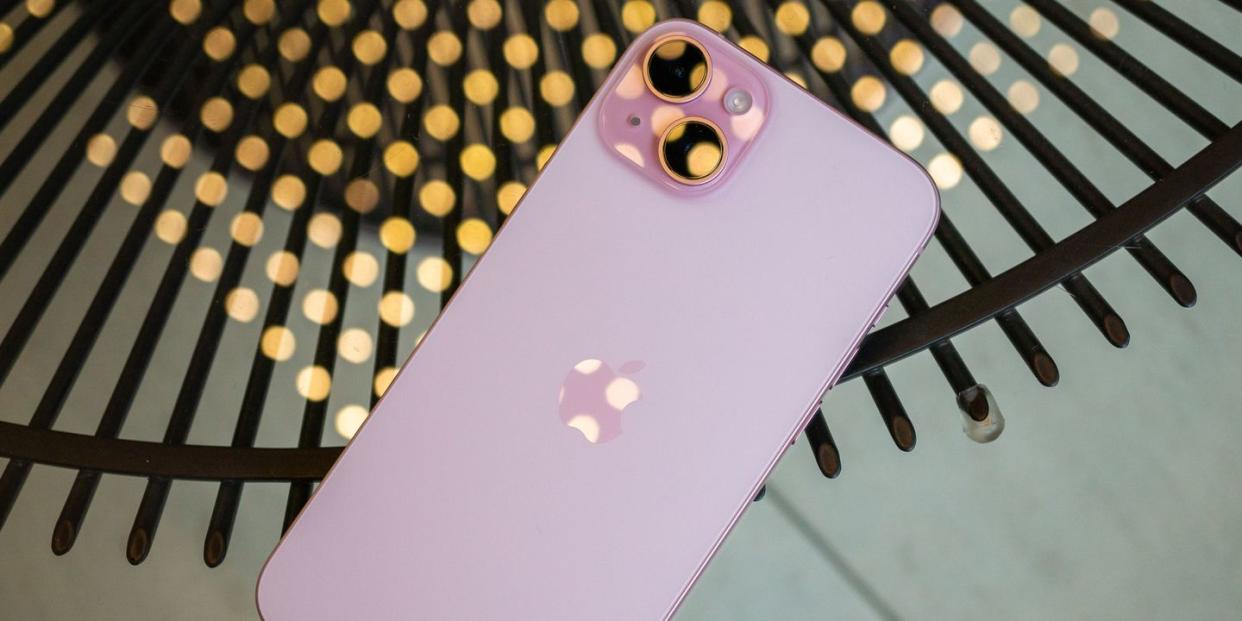
Look around at the Android phone market and you’ll see a lot of sizable phones. The Google Pixel 7 has a 6.3-inch display, the Nothing Phone (2) has a 6.7-inch screen, and the OnePlus 11 matches it. Yes, the Samsung Galaxy S23 starts at a smaller 6.1 inches, but it would be easy to argue that this size feels a little petite compared to most, and it’s what most iPhones have stuck to since 2018.
In the past, those wanting a bigger iPhone would have to fork out all the extra cash needed for the premium iPhone Pro Max models. In 2023, though, our recommendation for most shoppers wanting a more expansive screen is the iPhone 15 Plus, a larger version of the standard iPhone 15, which comes with a 6.7-inch display.
Yes, Apple did release an iPhone 14 Plus last year and we recommended it for its size and battery life, but its price kept it too close to the Pro models. This year, the calculations are easier: the 15 Plus starts at £899, while the 15 Pro Max is at least £1,199.
This is easily the best-value big iPhone, and that’s before even talking about the upgrades – the 15 Plus includes a revamped high-resolution camera system with 2x zoom, a smart “Dynamic Island” within its display, a useful USB-C port for charging and data, and a speedier A16 Bionic processor. If your current phone is older and it’s time for a change, or you’ve just been eager for a bigger panel and more battery life, the iPhone 15 Plus makes for a noticeable step up.
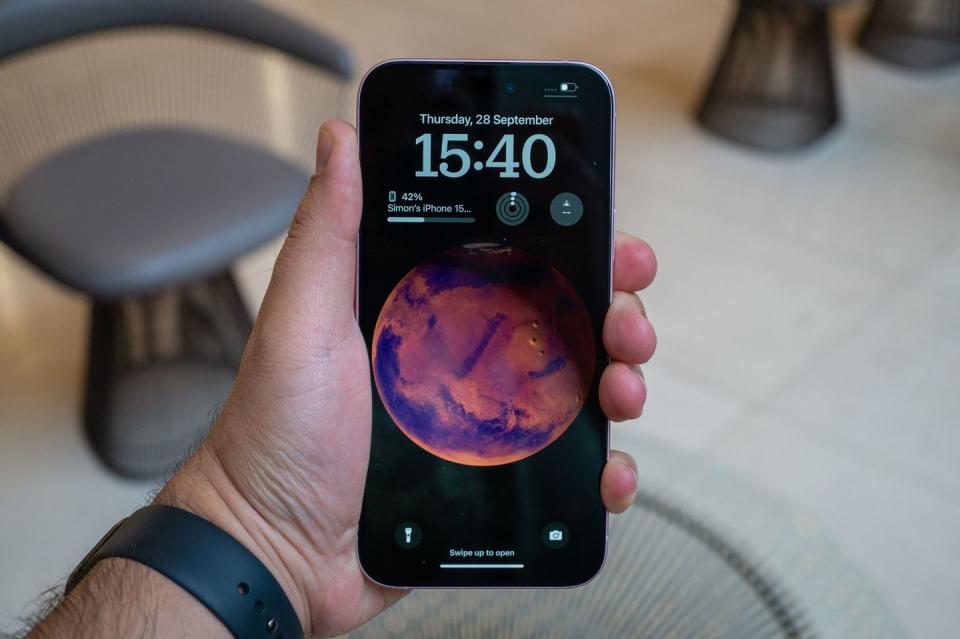
iPhone 15 Plus key specs
Screen size: 6.7-inch
Resolution: 2796 x 1290 pixels
Operating system: iOS 17
Processor: A16 Bionic
Cameras: 48MP main, 12MP ultra-wide, 12MP 2x telephoto, 12MP front-facing
Battery life: Up to 26 hours
Storage: 128GB, 256GB, 512GB
Weight: 201g
Water resistance: Yes, IP68
Micro SD card slot: No
iPhone 15 Plus design
It may sound like a small difference but the extra screen size makes using this phone a bit of an adjustment if you’re coming from most older iPhones. We think many people will adjust to it, but there’s no way around it. The iPhone 15 Plus is just big. It’s worth knowing that it may be a little difficult to get around the interface single-handedly, and we’re aware that could be a deal-breaker for some.
One good thing, though, is that Apple has slightly “contoured” the edges of the handset so you’ll find it more comfortable to hold. We like the matte texture of the back glass, and this is, overall, a marginally nicer phone to handle than the 14 Plus. Beyond that, there isn’t a substantial change to the look of the phone, but we do really appreciate that it’s a less slippery design compared to most. It’s impossible to use any Google Pixel model without a case, but you could realistically hold the 15 Plus without one, even if we’d still put one on for protection.
We’re fans of the softness and minimalism of the colour range available for the iPhone 15 and 15 Plus, and if you prefer a less eye-catching look it’s still available in black. Beyond that, you’ve got green, pink, blue and yellow shades, all in subtle pastel tones that we think look lovely and make for especially good options if you’re planning to put your phone in a clear case. Our review unit for the 15 Plus is pink, but we’ve also been hands-on with the blue iPhone 15, and the rest of the hues at Apple’s launch event. The blue is arguably the least colourful, almost looking white in some conditions, but the pink, green and yellow are all distinctive.
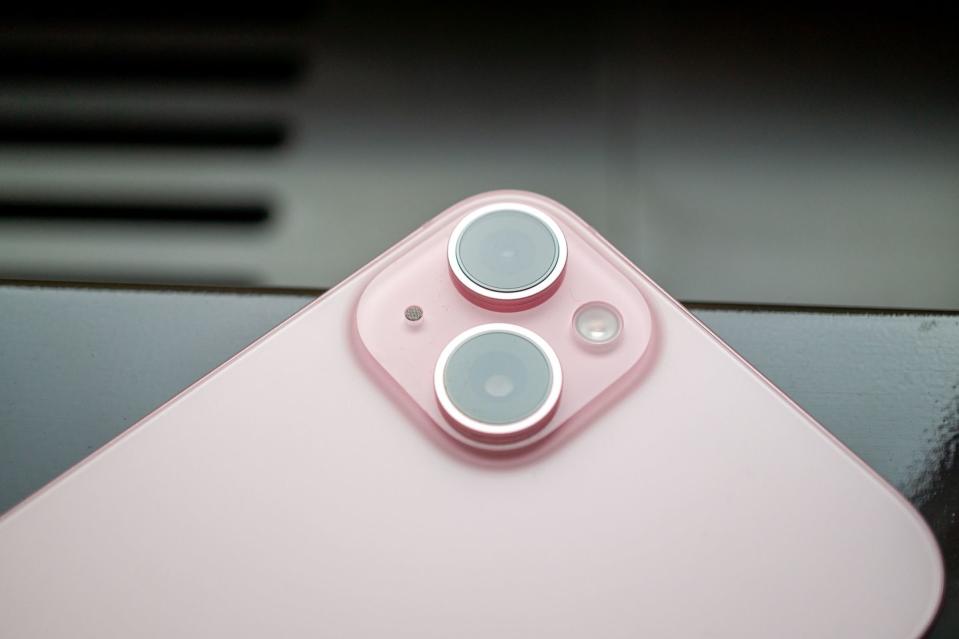
iPhone 15 Plus camera
As on the iPhone 15, Apple has now introduced a 48-megapixel (MP) sensor to its 15 Plus, promising improved light capture and a 24MP main sensor output. This high-resolution performance matches what Apple delivered in the 14 Pro models last year, and this camera system holds its own.
The 12MP ultra-wide and front-facing lenses remain unchanged but benefit from enhanced night mode and upgraded high dynamic range (HDR) capabilities. You may think you’re missing out on a third telephoto lens, but the 15 Plus does now have a 2x zoom feature that leverages the central portion of the big sensor for 12MP photos, a first for the core iPhone series. We think this is more functional than a 3x or 5x zoom for most portraiture, although we understand why some people need more reach and that would be one reason to step up to the Pro models.
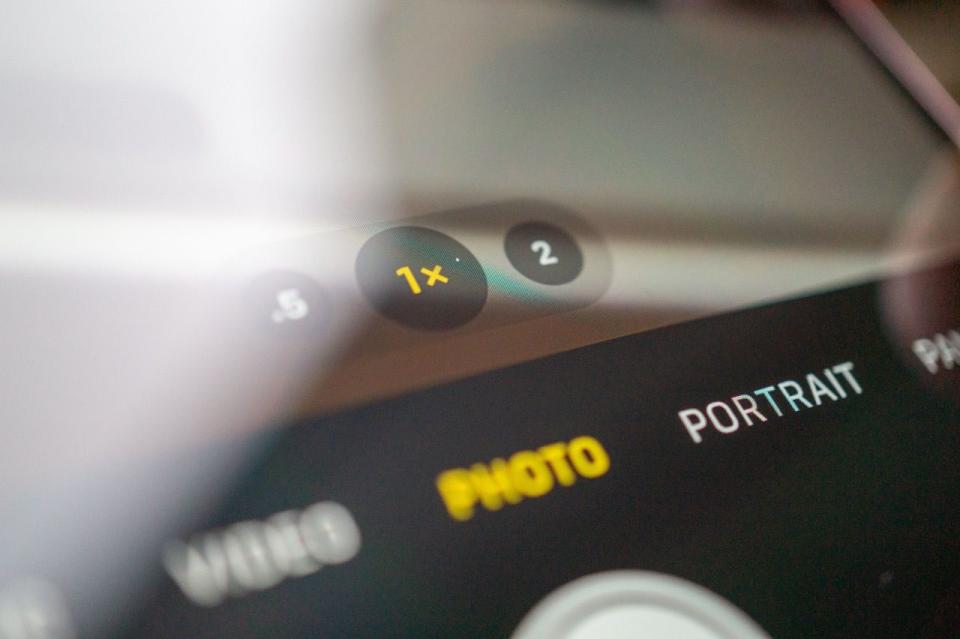
Need more resolution? You’ve got it. Within the settings, you also have the choice of a 48MP "Max" mode for high-resolution HEIF or JPEG files, with file sizes hovering around 5MB for HEIF Max and 10MB for JPEG Max. HEIF, short for "High-Efficiency Image File Format," is a more efficient file format, albeit not as widely adopted as JPEG.
Another noteworthy upgrade is Apple's "next-gen" portrait capture, which automatically activates when the camera detects people or specific pets (currently limited to cats and dogs). Post-capture, you can fine-tune background blur and move around the focus point (within reason).
In our hands-on tests, this camera establishes itself as a standout performer for portraits, landscapes and close-up shots. It feels like Apple has eased up on some of the post-processing too, resulting in a more neutral output than Samsung phones and the Pixel series. The results are impressive straight out of the camera, but you still have room for editing, and you can use “Photographic Styles” to give shots your own look if you’d prefer them, whether that’s “Vibrant” or “Rich Contrast”. Together, the new portrait control, improved night mode, and 48MP sensor deliver a substantial change to the cameras available on the main iPhone lineup.
Below, we've included a gallery of unaltered photo samples taken with the iPhone 15 Plus camera system.
iPhone 15 Plus display
There are areas where the iPhone 15 Plus display is a top performer. For instance, it now hits a peak brightness of 2000 nits, almost double its predecessor and far more than the Pixel 7’s maximum brightness of 1400 nits. This OLED panel also just beats the Pixel when it comes to its resolution, with the Pixel offering 1080 x 2400 pixels compared to 2796 x 1290 pixels on the 15 Plus (or 2556 x 1179 pixels on the iPhone 15).
However, there’s one clear area where the iPhone screen is still a bit of a letdown, and that’s Apple’s puzzling decision to continue to omit features like a higher refresh rate and an always-on display from its main iPhone lineup. We get that this is one way to distinguish it from the Pro, but these features are commonplace on budget Android phones.
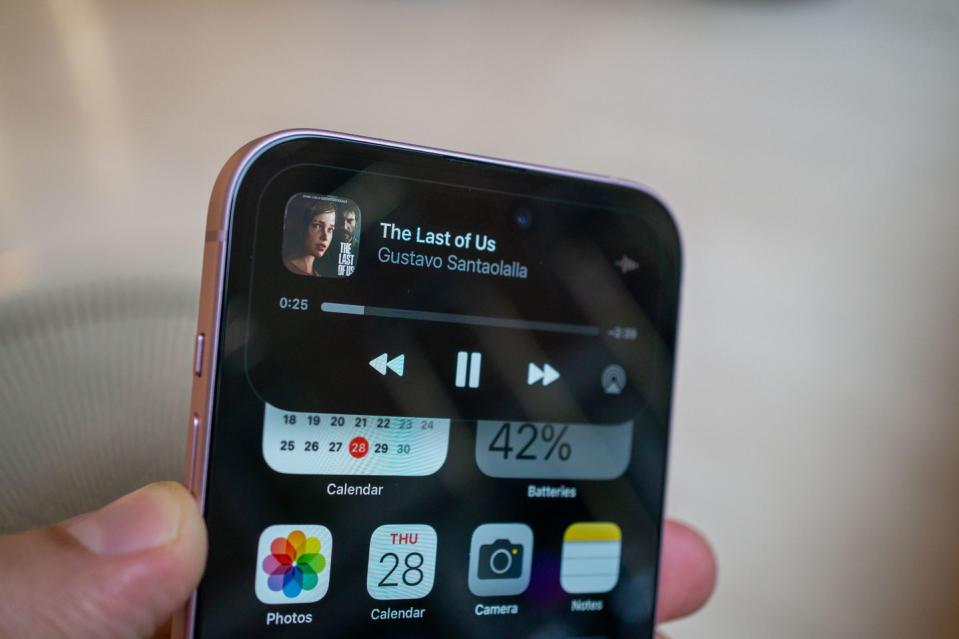
The benefits of a higher refresh rate might not be obvious to most users, but the convenience of an always-on display is hard to deny. You can see the time, date and other status information at a glance – we can confirm it’s handy after using it for the past year on the iPhone 14 Pro. Also, iOS 17 introduces a "StandBy" mode to turn the iPhone into a glanceable smart clock while charging horizontally. This would be a great way to make use of the massive screen on the 15 Plus, but while it technically works it’s not usable due to its screen timeout.
On the positive side, though, we love that Apple brought the "Dynamic Island" feature, previously exclusive to Pro models, to the iPhone 15 and 15 Plus. This replaces the notch with a pill-shaped area around the front-facing camera, displaying real-time information effectively. It's a feature we appreciate, despite its name, and it’s great for tracking an Uber Eats order, following directions from a mapping app, staying aware of a timer or just seeing the currently playing song at the top of your screen.
iPhone 15 Plus performance and battery life
The iPhone 15 boasts the A16 Bionic chip, which launched with the iPhone 14 Pro in 2022. This chip delivers impressive speed and efficiency, in line with Apple's reputation for A-series superiority.
We doubt you’ll see a huge difference in day-to-day usage, but the A16 Bionic enhances device-based machine learning and expands camera capabilities, making the phone both smarter and faster. What you’ll miss out on with this model, though, is all those extra smarts coming to the Pro models with the A17 Pro chip, and that’s what enables those phones to handle the kind of gameplay you’d expect from a console. This is a headline feature for the 15 Pro and 15 Pro Max, so if you’re a gamer who wants to play Death Stranding or Resident Evil Village on your iPhone, you’ll need to go for the Pro.
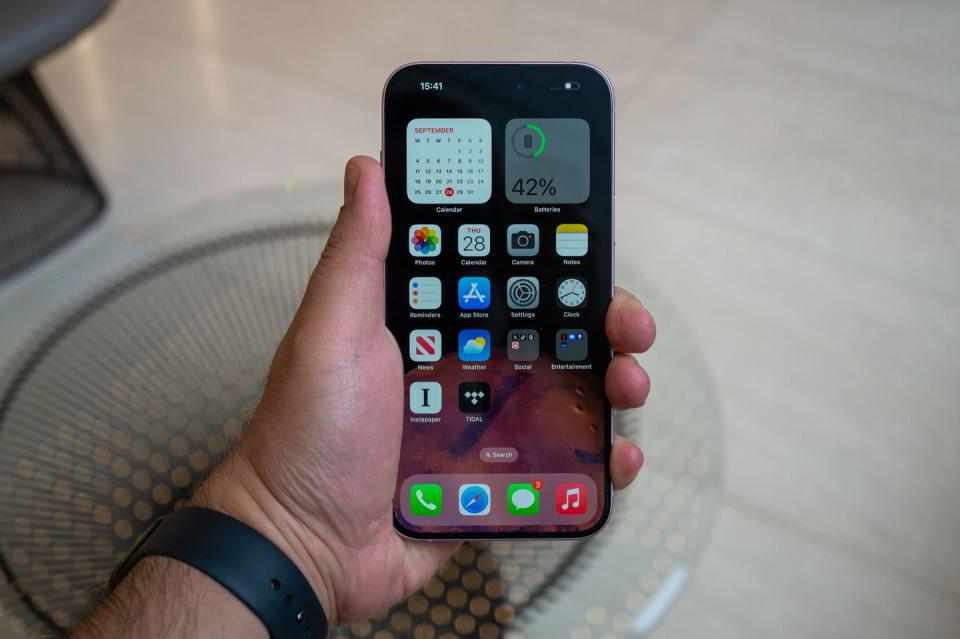
As for the battery life, Apple maintains its "all-day battery life" claim, promising up to 26 hours of video playback from the iPhone 15 Plus. Under certain conditions, Apple reports that the iPhone 15 Plus bests the 15 Pro Max in the battery life head-to-head, as it’s rated to last longer when it comes to audio playback (up to 100 hours, rather than 95 hours).
Like the 14 Plus, where we found it possible to achieve multi-day battery life, this is a top performer that we’ve found delivers exceptional longevity in normal use and with automatic brightness switched on for the screen. Of course, if you max out the brightness and spend the whole day on TikTok, it’ll deplete faster, but under normal use – like listening to music and podcasts during the commute and while working, playing some YouTube videos during lunch and regular emails and messaging – we haven’t had any trouble getting this to last for two full days.
iPhone 15 Plus connectivity and charging
For us, USB-C is a major highlight of all the iPhone 15 models, which now adopt the port and completely abandon the Lightning connector after its decade-long run. This feels like an overdue change, given how standardised USB-C is on everything from Bluetooth speakers to tablets, Kindles, headphones, laptops, earbuds and power banks. Apple even went ahead and made a new version of the AirPods Pro with a USB-C port.
The iPhone already offered a good variety of swift recharging options, supporting both MagSafe (up to 15W) and Qi wireless charging (up to 7.5W) but now you’ve also got that main port for wired charging and that’ll replenish around 50% of your battery in about 30 minutes with a 20W or higher adapter. That is about the same as Lightning, but this is a far more versatile port. It’s also worth mentioning that we vastly prefer the new braided charging cable included in the box over the previous one.
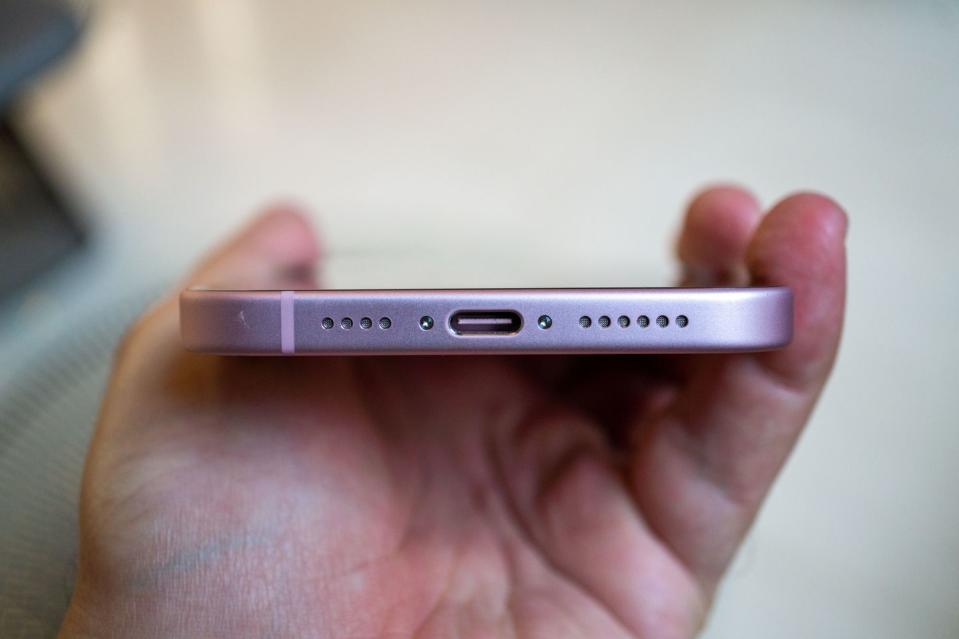
On that versatility, which is the true appeal of the USB-C addition, we’ve found it seamless to connect to a wide range of devices, from DACs for wired headphones and SD card readers to power banks and external storage. This port serves multiple purposes, enabling data transfers, compatibility with gaming controllers like the Backbone One, and the use of USB-C EarPods. Moreover, it allows for recharging other phones, earbuds cases and Apple Watches from your phone’s own battery. It’s not something you’ll use much, but if it’s a feature you ever need, you’ll be glad it’s there.
The one thing worth mentioning, though, is that it’s not quite as fast for moving data around as the port on the Pro iPhones, and it’s limited to USB 2 speeds. This is plenty for most people, but there’s a reason why photographers and videographers are going to be more keen on the USB 3 file transfers available on the 15 Pro series.
iPhone 15 Plus drawbacks
There’s a notably short list of downsides to the iPhone 15 and the 15 Plus, but the most significant of them is the lack of the always-on display and variable refresh rate. Apple’s refusal to add these is just a shame – they’re common in affordable Android competitors and it means the new “StandBy” mode feels incomplete on this phone.
Beyond that, we just don’t have many complaints that are significant enough to call dealbreakers. Yes, we’d love a customisable “action button” like there is on the Pro phones, it could’ve enriched the standard iPhone 15 and 15 Plus, but it is more of an added bonus. We could say the same about the slightly slower file transfer speeds, this’ll only be a disappointment to a select group of iPhone users. And we think the same could be said for the phone being not quite as fast to charge as some Androids. It’s a minor drawback.
The one thing we’d reiterate is that the screen size is a big change if you’re coming from a small phone. The iPhone 15 Plus does feel quite big. That comes with its added benefits that make it better for videos, watching Netflix, FaceTime calls, framing your photos and viewing loads of text in one go, but there will be an inevitable adjustment period. For some, it’ll be unwieldy and definitely hard to use one-handed.
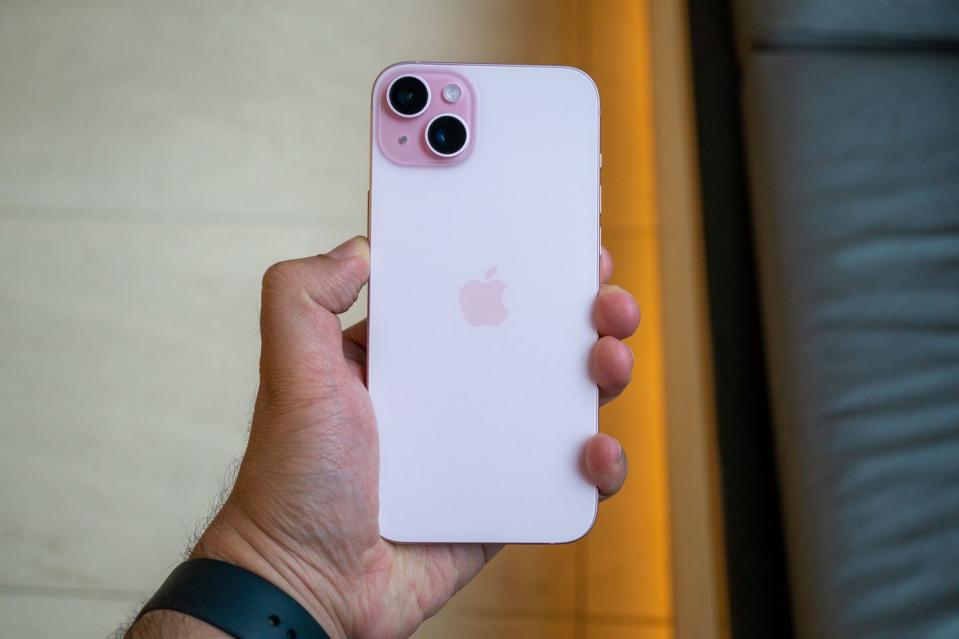
iPhone 15 Plus verdict
Both the iPhone 15 and the iPhone 15 Plus are identical except for the difference in the size of the body and screen, the battery life and the price. And, now that the 15 Plus is £50 more affordable than the iPhone 14 Plus was last year, we think it’s a great value way to get a terrific iPhone with a bigger screen and loads of battery.
Beyond that, everything we love about the iPhone 15 remains true. It’s more than an incremental update thanks to the number of features included from last year’s “pro” models – we love that it has an evidently better camera with that 48MP main shooter and the new portrait mode, the smart Dynamic Island and the faster processor.
We still rate the iPhone 14 Plus if you want a big-screen iPhone for a lower price, but we do think the addition of USB-C on the 15 Plus makes it a more future-proof option for most buyers looking to keep their phone for several years.
You Might Also Like

